User:KJP1/sandbox 5 Monmouthshire gardens

Monmouthshire is a county and principal area of Wales. It borders Torfaen and Newport to the west; Herefordshire and Gloucestershire (in England) to the east; and Powys to the north. The largest town is Abergavenny, with other large settlements being Chepstow, Monmouth, and Usk.[1] The present county was formed under the Local Government (Wales) Act 1994, and comprises some sixty percent of the historic county.[2] Between 1974 and 1996, the county was known by the ancient title of Gwent,[3] recalling the medieval Welsh kingdom.[4] The county is 850 km2 (330 sq mi) in extent,[5] with a population of 95,200 as of 2020[update].[6]
The Cadw/ICOMOS Register of Parks and Gardens of Special Historic Interest in Wales was established in 2002 and given statutory status in 2022.[7] Its heightened status reflected a growing recognition of the importance of historic landscapes; Elisabeth Whittle, later president of the Welsh Historic Gardens Trust writing; "historic parks and gardens are an integral part of the Welsh archaeological and architectural heritage."[8] The register is administered by Cadw, the historic environment agency of the Welsh Government. It includes just under 400 sites, covering the gardens and parkland of private houses, historic deer parks, cemeteries, common land and public parks. Sites are listed at one of three grades, matching the grading system used for listed buildings. Grade I is the highest grade, for landscapes of exceptional interest; Grade II*, the next highest, denotes parks and gardens of more than special interest; while Grade II denotes nationally important sites of special interest.[9][7]
There are 48 registered parks and gardens in Monmouthshire. Five are listed at grade I, nine at grade II*, and thirty-four at grade II.
Key
[edit]| Grade | Criteria[10] |
|---|---|
| I | Parks and gardens of exceptional interest, sometimes considered to be internationally important |
| II* | Particularly important parks and gardens of more than special interest |
| II | Parks and gardens of national importance and special interest |
List of parks and gardens
[edit]| Name | Location Grid Ref.[note 1] Geo-coordinates |
Date Listed | Site type | Description / Notes | Grade | Reference Number | Image |
|---|---|---|---|---|---|---|---|
| Abergavenny Castle | Abergavenny SO 29856 14011 51°49′13″N 3°01′09″W / 51.820302°N 3.019071°W |
1 February 2022 | Park | The grounds of the medieval castle ruins were landscaped c. 1800 with walks created within the curtain walls. In the later nineteenth century further landscaping took place, a formal garden was laid out, and the castle grounds became a public park.[11] | II | PGW(Gt)9(MON) | 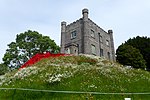
|
| Abergavenny Priory Deer Park | Abergavenny SO 28443 17784 51°51′15″N 3°02′25″W / 51.854040°N 3.040349°W |
1 February 2022 | Deer park | The deer park of Abergavenny Priory, dating from the later Middle Ages. Originally some 500 acres in extent, the park boundaries, comprising ditches, earthern banks and walls, remain visible in small stretches.[12] | II | PGW(Gt)55(MON) | 
|
| Bailey Park | Abergavenny SO 30089 14638 51°49′33″N 3°00′57″W / 51.825967°N 3.0158180°W |
1 February 2022 | Urban park | Laid out in 1884 on land donated by Crawshay Bailey, Junior, Bailey Park is a good example of a late-Victorian urban park. It contains the site of a lido, built in 1939 and demolished in the early 21st century.[13][14] | II | PGW(Gt)60(MON) | 
|
| Bertholey House | Llantrisant Fawr ST 39682 94561 51°38′48″N 2°52′23″W / 51.646594°N 2.873155°W |
1 February 2022 | Garden | An early 19th century landscape park which formed the grounds to Bertholey House. The house was almost completely destroyed in a fire in 1905 but was restored in the early 21st century.[15][16] | II | PGW(Gt)11(MON) | 
|
| Brynderwen | Llanarth SO 35504 06952 51°45′27″N 2°56′09″W / 51.757524°N 2.935826°W |
1 February 2022 | Park | The landscape park to Brynderwen Court, laid out in the 1830s when the house was built.[17] | II | PGW(Gt)12(MON) | 
|
| Cefn Ila | Llanbadoc SO 36195 00429 51°41′56″N 2°55′29″W / 51.698962°N 2.924618°W |
1 February 2022 | Park | The landscape park to Cefn Ila House, which burnt down in 1973. The estate is now owned by the Woodland Trust.[18] | II | PGW(Gt)63(MON) | 
|
| Cefntilla Court | Llandenny SO 40480 02967 51°43′20″N 2°51′47″W / 51.722251°N 2.863059°W |
1 February 2022 | Garden and park | The gardens and grounds were created, and the present house built, in the 1850s for Richard Somerset, 2nd Baron Raglan, as a memorial to his father, Lord Raglan, British commander in the Crimean War.[19] | II | PGW(Gt)31(MON) | 
|
| Chapel House | Monmouth SO 50828 13264 51°48′57″N 2°42′53″W / 51.815829°N 2.714728°W |
1 February 2022 | Garden | An early 18th century town house garden, with terraces down to the River Monnow.[20] | II | PGW(Gt)43(MON) | 
|
| Chepstow Park | Devauden ST 48209 99050 51°41′16″N 2°45′02″W / 51.687804°N 2.750596°W |
1 February 2022 | Deer park | The deer park of Chepstow Castle.[21] | II | PGW(Gt)61(MON) | 
|
| Chippenham Mead | Monmouth SO 50689 12523 51°48′33″N 2°43′00″W / 51.809155°N 2.716639°W |
1 February 2022 | Urban park / common land | Originally common land, later developed as an urban park. In the 19th century, it was notable for its horse racing events and in the 21st it accommodates sports grounds and a children's playground.[22] | II | PGW(Gt)6(MON) | 
|
| Clytha Park | Clytha SO 36439 09013 51°46′34″N 2°55′22″W / 51.776159°N 2.922659°W |
1 February 2022 | Park | Clytha Park is "the finest early nineteenth century Greek Revival house in the county",[23] and its parkland contains Monmouthshire's "two outstanding examples of late eighteenth century Gothic", the gates to the park and Clytha Castle.[23] The park was laid out in the very late 18th century for William Jones.[24] | I | PGW(Gt)15(MON) | 
|
| Coldbrook Park | Llanover SO 31333 12678 51°48′31″N 2°59′51″W / 51.808502°N 2.997381°W |
1 February 2022 | Park | The house at Coldbrook was demolished in 1954 but many of the features of its 18th century landscape park remain.[25] | II | PGW(Gt)30(MON) | 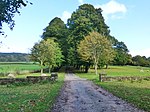
|
| Dewstow House | Caldicot ST 48209 99050 51°35′46″N 2°45′02″W / 51.596152°N 2.750596°W |
1 February 2022 | Garden | The underground gardens at Dewstow House were laid out in the first two decades of the 20th century by Henry Oakley. They form a remarkable series of subterranean caverns and pools, constructed of Pulhamite, an artifical stone. Largely covered over in the later 20th century, they were rediscovered and restored in the 21st.[26] | I | PGW(Gt)44(MON) | 
|
| Dingestow Court | Dingestow SO 45064 09715 51°47′00″N 2°47′52″W / 51.783385°N 2.797773°W |
1 February 2022 | Park | An important Victorian park and garden designed by Edward Milner.[27] | II* | PGW(Gt)1(MON) | 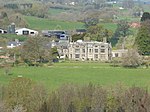
|
| Glen Usk | Llanhennock ST 36249 92734 51°37′47″N 2°55′21″W / 51.629790°N 2.922431°W |
1 February 2022 | Garden | The first gardens at Glen Usk were contemporaneous with the 1830s house. In the 1920s, areas around the tennis court were redeveloped and terraced in an Arts and Crafts style.[28] | II | PGW(Gt)36(MON) | 
|
| High Glanau | Mitchel Troy SO 49726 07453 51°45′49″N 2°43′48″W / 51.763489°N 2.729869°W |
1 February 2022 | Garden | The last of three important gardens in Monmouthshire designed and developed by Henry Avray Tipping for himself. All are listed at Grade II*. High Glanau, laid out between 1922 and 1929, contained terraces, pools and a pergola.[29] Much of Tipping's plating was destroyed in the 1960s, and a swimming pool was dug out on the top terrace. Restoration has been carried out in the 21st century by Tipping's biographer.[30][31] | II* | PGW(Gt)45(MON) | 
|
| Hilston Park | Newcastle SO 44575 18784 51°51′54″N 2°48′23″W / 51.864868°N 2.806316°W |
1 February 2022 | Park | A 19th century landscape park with a lake and a folly.[32] | II | PGW(Gt)22(MON) | 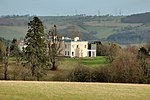
|
| Itton Court | Itton ST 49252 95517 51°39′22″N 2°44′06″W / 51.656136°N 2.734995°W |
1 February 2022 | Park | A landscape park with evidence of developments from the 17th to the 20th centuries.[33] | II | PGW(Gt)21(MON) | 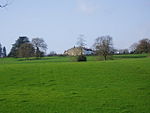
|
| Linda Vista Garden | Abergavenny SO 29534 14096 51°49′16″N 3°01′26″W / 51.821025°N 3.023759°W |
1 February 2022 | Urban park | A small urban park developed in the mid 20th century from a private garden laid out in the 1870s.[34] | II | PGW(Gt)59(MON) | 
|
| Llanarth Court | Llanarth SO 37972 10519 51°47′24″N 2°54′03″W / 51.789871°N 2.900712°W |
1 February 2022 | Park | An early 19th century park, with possible attributions to Samuel Lapidge, a pupil of Capability Brown, and John Claudius Loudon. Much has been lost, the lake is silted up, and the formal gardens have largely returned to pasture.[35] | II | PGW(Gt)13(MON) | 
|
| Llanvihangel Court | Llanvihangel Crucorney SO 32781 20411 51°52′42″N 2°58′40″W / 51.878195°N 2.977887°W |
1 February 2022 | Park | Remnants of an important 17th century park, including avenues of Scots pine and sweet chesnut to the north and south.[36] | I | PGW(Gt)14(MON) | 
|
| Llangibby House | Llangybi ST 36927 97303 51°40′15″N 2°54′48″W / 51.670942°N 2.913462°W |
1 February 2022 | Park | The house was demolished in the 1950s and its gardens are largely ruined. In the 18th century the bailey of Tregrug Castle in the grounds was used as a bowling green. An avenue of Scots pine runs from the site of the house down to the River Usk.[37] | II | PGW(Gt)27(MON) | 
|
| Llanover Park | Llanover SO 32150 08061 51°46′02″N 2°59′05″W / 51.767097°N 2.984628°W |
1 February 2022 | Park | In the 19th century Llanover was the home of Augusta Hall, Baroness Llanover and of her husband, Benjamin. A noted champion of Welsh culture, Lady Llanover was known as "Gwenynen Gwent", ('the bee of Gwent'). The Halls' house was demolished in the 20th century, but the gardens, parkland and estate village survive.[38][39] | II* | PGW(Gt)41(MON) | 
|
| Llantilio Court | Llantilio Crossenny SO 40166 15045 51°49′51″N 2°52′11″W / 51.830799°N 2.869690°W |
1 February 2022 | Park | The parkland to the, now demolished, Llantilio Court. The gardens, including a lakeside Japanese garden are mostly lost, but the outlines of the park survive.[40] | II | PGW(Gt)7(MON) | 
|
| Lower Duffryn House | Grosmont SO 43518 22730 51°54′01″N 2°49′20″W / 51.900236°N 2.822312°W |
1 February 2022 | Garden | The rare remnants of a Tudor garden.[41] | II | PGW(Gt)24(MON) | 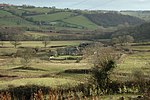
|
| Mathern Palace | Mathern ST 52290 90821 51°36′51″N 2°41′26″W / 51.614183°N 2.690440°W |
1 February 2022 | Garden | The grounds of an episcopal palace of the Mediaeval Bishops of Llandaff, the building was restored from 1894 as his home by Henry Avray Tipping. Tipping laid out the garden in an Arts and Crafts style.[42] | II* | PGW(Gt)35(MON) | 
|
| Mounton House | Mounton ST 51299 93054 51°38′03″N 2°42′18″W / 51.634174°N 2.705063°W |
1 February 2022 | Garden | Another house and garden by Henry Avray Tipping, supported by Eric Francis, a local architect from Chepstow, Mounton was completed in the first decades of the 20th century, between the reconstruction of Mathern and the building of High Glanau.[43] | II* | PGW(Gt)8(MON) | 
|
| Moynes Court | Mathern ST 52010 90964 51°36′56″N 2°41′40″W / 51.615445°N 2.694504°W |
1 February 2022 | Garden | The bones of a Mediaeval and Tudor garden, with extant walls and fish ponds, but the planting is entirely of the 20th and 21st centuries.[44] | II | PGW(Gt)34(MON) | 
|
| Nelson Garden | Monmouth SO 50779 12728 51°48′40″N 2°42′55″W / 51.811006°N 2.715363°W |
1 February 2022 | Garden | An 18th century town house garden, with a pavilion which commemorates a visit to the town by Lord Nelson in 1802.[45] | II | PGW(Gt)57(MON) | 
|
| New Cemetery | Abergavenny SO 29856 14011 51°49′05″N 3°01′52″W / 51.818013°N 3.030988°W |
1 February 2022 | Cemetery | The Royal Commission on the Ancient and Historical Monuments of Wales (RCAHMW) describes New Cemetery as a "good example of a well-preserved Victorian landscaped garden cemetery." To the south-west of the town, the cemetery was laid out at the end of the 19th century with much evergreen planting with graves and tombs accessed via gravel paths.[46] | II | PGW(Gt)37(MON) | 
|
| Pant-y-Goitre House | Llanfair Kilgeddin SO 34569 08678 51°46′23″N 2°56′59″W / 51.772932°N 2.949696°W |
1 February 2022 | Park | The park to a much altered and extended house, laid out from 1770 with woods, a lake, lodges and a ha-ha.[47] | II | PGW(Gt)10(MON) | 
|
| Penhein | Llanvair Discoed ST 44971 93144 51°38′04″N 2°47′47″W / 51.634399°N 2.796499°W |
1 February 2022 | Park | An early 19th century park with some notable specimen trees including American redwoods and a Monkey Puzzle.[48] | II | PGW(Gt)53(MON) | 
|
| Piercefield House | St Arvans ST 52810 95680 51°39′28″N 2°41′01″W / 51.657913°N 2.683588°W |
1 February 2022 | Park | Monmouthshire's best example of an 18th century Picturesque landscape, Piercefield Park is listed jointly with The Wyndcliff. The latter offers panoramic views over the Lancaut cliffs to the River Wye, while the former contains many remnants of a walk that became an essential element of the Wye Tour in the 18th and early 19th centuries, including the Giant's Cave, a grotto and a number of viewing points. Piercefield House itself is a ruin that is not publicly accessible but access to the grounds can be made via public footpaths.[49] | I | PGW(Gt)40(MON) | 
|
| Raglan Castle | Raglan SO 41343 08373 51°46′15″N 2°51′05″W / 51.770942°N 2.851481°W |
1 February 2022 | Garden | The gardens at Raglan are almost entirely concealed under pasture, but their Grade I listing indicates their significance. The RCAHMW suggests they are an "outstandingly important sixteenth- and early seventeenth-century garden layout which was one of the most advanced gardens of its date in the country." Developed from the 1550s by the Earls of Worcester to complement their palatial castle, the gardens comprised a long bank of three terraces to the north, leading down to a large lake known as the 'great poole'; a bowling green and a moat walk around the Great Tower; and elaborate parterres and water gardens to the east.[50] | I | PGW(Gt)42(MON) | 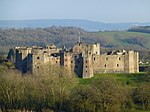
|
| Shirenewton Hall | Shirenewton ST 47998 93463 51°38′15″N 2°45′10″W / 51.637555°N 2.752815°W |
1 February 2022 | Garden | The gardens date mainly from the 19th and early 20th centuries, and include Chinese and Japanese-influenced gardens, created by the then owner Charles Liddell who had made his fortune through trading in the East.[51] | II* | PGW(Gt)46(MON) | 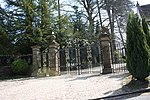
|
| St John's House | Monmouth SO 50737 12784 51°48′41″N 2°42′58″W / 51.811506°N 2.715980°W |
1 February 2022 | Garden | A town house garden dating from the dating from the 19th century. It contains a cast iron Coalbrookdale verandah.[52] | II | PGW(Gt)47(MON) | 
|
| St Pierre Park | Mathern ST 51506 90573 51°36′43″N 2°42′06″W / 51.611886°N 2.701728°W |
1 February 2022 | Park | The park, and the ancient mansion, are almost completely enveloped by the St Pierre Golf and Country Club, but traces of the 18th century park, and the earlier deer park, remain.[53] | II | PGW(Gt)29(MON) | 
|
| Tal-y-coed Court | Llanvihangel-Ystern-Llewern SO 42127 15210 51°49′57″N 2°50′29″W / 51.832489°N 2.841264°W |
1 February 2022 | Garden | The Tal-y-coed estate was owned in the late 19th and early 20th centuries by Joseph Bradney, an antiquarian and author of A History of Monmouthshire from the Coming of the Normans into Wales down to the Present Time, a multi-volume history of the county. Bradney had a new house built and laid out the gardens and park in the 1880s and 1890s.[54] | II | PGW(Gt)52(MON) | 
|
| The Argoed | Penallt SO 52301 08442 51°46′21″N 2°41′34″W / 51.772606°N 2.692697°W |
1 February 2022 | Garden | An ancient home of the Proberts, in the 19th century the house was owned by Richard Potter, father of Beatrice Webb]], whose friend, George Bernard Shaw was a frequent visitor. The gardens, laid out in typical Victorian style, have views over the River Wye.[55] | II | PGW(Gt)49(MON) | 
|
| The Hendre | Llangattock-Vibon-Avel SO 45868 14128 51°49′23″N 2°47′13″W / 51.823137°N 2.786810°W |
1 February 2022 | Park | John Rolls, 1st Baron Llangattock employed Henry Ernest Milner from the 1870s to lay out "the grandest and most important Victorian park and garden in Monmouthshire."[56] The centre of a major estate, the gardens and park boasted drives, rockeries, a lake, cascades, and multiple lodges, including one in the guise of a Swiss Cottage, designed by Sir Aston Webb.[57] The Hendre is now the site of the Rolls of Monmouth Golf Club.[58] | II* | PGW(Gt)17(MON) | 
|
| The Hill | Abergavenny SO 29551 15433 51°49′59″N 3°01′26″W / 51.833046°N 3.023785°W |
1 February 2022 | Garden | The gardens and grounds of The Hill were developed in the 19th century as a "mini country estate" to the north of the town. Much has been lost to residential development in the 21st century. [59] | II | PGW(Gt)62(MON) | 
|
| The Kymin | Monmouth SO 52765 12498 51°48′33″N 2°41′11″W / 51.809110°N 2.686526°W |
1 February 2022 | Garden | The Kymin was developed in the late 18th century as a picnic spot and bowling green by members of the Monmouth bourgeoisie. The Round Tower was constructed as a Banqueting house and the Monmouth antiquarian and publisher Charles Heath recorded in his 1807 history; Descriptive Account of the Kymin Pavilion and Beaulieu Grove with their various views; also a description of the Naval Temple that ten counties could be seen from its upper storey; (Gloucestershire, Monmouthshire, Glamorganshire, Breconshire, Montgomeryshire, Worcestershire, Herefordshire, Radnorshire, Shropshire and Somerset).[60] After 1800 the Naval Temple was built to celebrate Britain's maritime victories.[61] Sir Richard Colt Hoare saw it in 1803 but was unimpressed, describing it as "in very bad taste".[62] | II | PGW(Gt)5(MON) | 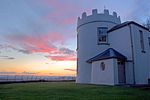
|
| Treowen | Mitchel Troy SO 46153 11109 51°47′46″N 2°46′56″W / 51.796024°N 2.782205°W |
1 February 2022 | Garden | There remain a few remnants of an early 17th century garden.[63] | II | PGW(Gt)23(MON) | 
|
| Trewyn House | Llanvihangel Crucorney SO 32872 22846 51°54′00″N 2°58′37″W / 51.900096°N 2.977040°W |
1 February 2022 | Park | Elements of the gardens and a small landscape park developed in the 18th century and re-worked in the 19th.[64] | II | PGW(Gt)28(MON) | 
|
| Troy House | Monmouth SO 50935 11352 51°47′55″N 2°42′46″W / 51.798649°N 2.712905°W |
1 February 2022 | Park | Troy was built c.1670 by Henry Somerset, 1st Duke of Beaufort as a wedding gift to his son Charles.[65] The gardens and park contain elements typical of an 18th century estate,[66] including an important walled kitchen garden which has a separate Grade II* listing.[67] The estate remains privately owned and was sold at auction, with the house in a state of considerable dilapidation, in 2021.[68] | II* | PGW(Gt)16(MON) | 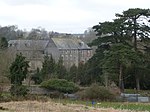
|
| Wonastow Court | Wonastow SO 48877 10983 51°47′43″N 2°44′34″W / 51.795147°N 2.742691°W |
1 February 2022 | Garden | The remains of an early garden and park, dating from the 16th or 17th centuries.[69] | II | PGW(Gt)56(MON) | 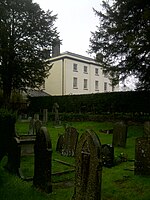
|
| Wyelands | Mathern ST 52358 91923 51°37′27″N 2°41′23″W / 51.624097°N 2.689609°W |
1 February 2022 | Park | An early 19th century park which is largely unaltered.[70] | II | PGW(Gt)51(MON) | 
|
| Wyndcliffe Court | St Arvans ST 51798 97252 51°40′19″N 2°41′54″W / 51.671960°N 2.698434°W |
1 February 2022 | Garden | A major Arts and Crafts garden by Henry Avray Tipping, laid out in 1922 for the owner of the court, Charles Clay.[71] | II* | PGW(Gt)4(MON) | 
|
See also
[edit]- List of scheduled monuments in Monmouthshire
- Grade I listed buildings in Monmouthshire
- Grade II* listed buildings in Monmouthshire
Notes
[edit]- ^ Sometimes known as OSGB36, the grid reference is based on the British national grid reference system used by the Ordnance Survey.
References
[edit]- ^ Evans 1953, p. 29.
- ^ "Clause 256 (Hansard, 20 July 1972)". api.parliament.uk. HMSO. Retrieved 30 July 2019.
- ^ Clark 1979, p. 207.
- ^ Clark 1980, p. 42.
- ^ "Monmouthshire – History, Facts, & Points of Interest". Encyclopedia Britannica. Retrieved 30 July 2019.
- ^ "Labour Market Profile - Monmouthshire". Nomis. Office for National Statistics. Retrieved 12 September 2021.
- ^ a b "Registered historic parks and gardens". Cadw. Retrieved 19 February 2023.
- ^ Whittle 1992, p. 6.
- ^ "Historic Parks and Gardens". Cadw. Archived from the original on 9 March 2012.
- ^ "Understanding registered historic parks & gardens: 2. What is registration?". Cadw. Retrieved 19 February 2023.
- ^ "Abergavenny Castle Garden (79029)". Coflein. RCAHMW. Retrieved 21 February 2023.
- ^ "Abergavenny Priory Deer Park (79015)". Coflein. RCAHMW. Retrieved 21 February 2023.
- ^ Smith, Lewis (15 October 2021). "The people campaigning to bring a lido back to Bailey Park". Wales Online. Retrieved 4 February 2023.
- ^ "Bailey Park, Abergavenny (408062)". Coflein. RCAHMW. Retrieved 21 February 2023.
- ^ "Bertholey House Park (700403)". Coflein. RCAHMW. Retrieved 21 February 2023.
- ^ "Bertholey House (36462)". Coflein. RCAHMW. Retrieved 21 February 2023.
- ^ "Brynderwen Park, Bettws Newydd (700131)". Coflein. RCAHMW. Retrieved 21 February 2023.
- ^ "Cefn Ila Park, Usk (700378)". Coflein. RCAHMW. Retrieved 21 February 2023.
- ^ "Cefn Tilla Park, Raglan (700337)". Coflein. RCAHMW. Retrieved 21 February 2023.
- ^ "Chapel House Garden, Monmouth (266090)". Coflein. RCAHMW. Retrieved 21 February 2023.
- ^ "Chepstow Park Wood Deer Park (408063)". Coflein. RCAHMW. Retrieved 21 February 2023.
- ^ "Chippenham Common, Monmouth (266091)". Coflein. RCAHMW. Retrieved 21 February 2023.
- ^ a b Newman 2000, p. 190.
- ^ "Clytha Park, Raglan (700398)". Coflein. RCAHMW. Retrieved 21 February 2023.
- ^ "Coldbrook House Park, Abergavenny (700246)". Coflein. RCAHMW. Retrieved 21 February 2023.
- ^ "Dewstow House Underground Water Garden, Calidcot (266053)". Coflein. RCAHMW. Retrieved 21 February 2023.
- ^ "Dingestow Court Park, Dingestow (700379)". Coflein. RCAHMW. Retrieved 21 February 2023.
- ^ "Glen Usk Gardens, Llanhennock (266028)". Coflein. RCAHMW. Retrieved 21 February 2023.
- ^ Gerrish 2011, p. 162.
- ^ "High Glanau Garden, Trellech (266087)". Coflein. RCAHMW. Retrieved 21 February 2023.
- ^ Gerrish 2015, p. 27.
- ^ "Hilston Park, Skenfrith (700380)". Coflein. RCAHMW. Retrieved 21 February 2023.
- ^ "Itton Court Park, Chepstow (700382)". Coflein. RCAHMW. Retrieved 21 February 2023.
- ^ "Linda Vista Gardens, Abergavenny (408061)". Coflein. RCAHMW. Retrieved 21 February 2023.
- ^ "Llanarth Court Park, Llanarth (700066)". Coflein. RCAHMW. Retrieved 21 February 2023.
- ^ "Llanfihangel Court Park, Llanfihangel Crucorney (700397)". Coflein. RCAHMW. Retrieved 21 February 2023.
- ^ "Llangibby Castle Garden, Llangybi (265981)". Coflein. RCAHMW. Retrieved 21 February 2023.
- ^ "Llanover Park, Llanover (700205)". Coflein. RCAHMW. Retrieved 21 February 2023.
- ^ "Llanover House (45084)". Coflein. RCAHMW. Retrieved 21 February 2023.
- ^ "Llantilio Court Park, Llantilio Crossenny (700407)". Coflein. RCAHMW. Retrieved 21 February 2023.
- ^ "Lower Dyffryn Garden, Grosmont (79021)". Coflein. RCAHMW. Retrieved 21 February 2023.
- ^ "Mathern Palace Garden, Chepstow (266065)". Coflein. RCAHMW. Retrieved 21 February 2023.
- ^ "Mounton House Gardens, Chepstow (266051)". Coflein. RCAHMW. Retrieved 21 February 2023.
- ^ "Moynes Court Garden, Mathern, Chepstow (266063)". Coflein. RCAHMW. Retrieved 21 February 2023.
- ^ "Nelson Garden, Monmouth (408060)". Coflein. RCAHMW. Retrieved 21 February 2023.
- ^ "New Cemetery, Abergavenny (79014)". Coflein. RCAHMW. Retrieved 21 February 2023.
- ^ "Pant-y-Goitre Park, Llanover (700405)". Coflein. RCAHMW. Retrieved 21 February 2023.
- ^ "Penhein Park, Llanfair Discoed (700242)". Coflein. RCAHMW. Retrieved 21 February 2023.
- ^ "Piercefield Park, Chepstow (266015)". Coflein. RCAHMW. Retrieved 21 February 2023.
- ^ "Raglan Castle Gardens, Raglan (266096)". Coflein. RCAHMW. Retrieved 21 February 2023.
- ^ "Shirenewton Hall Gardens and Grounds, Shirenewton (266049)". Coflein. RCAHMW. Retrieved 21 February 2023.
- ^ "St John's Garden, Monmouth (266092)". Coflein. RCAHMW. Retrieved 21 February 2023.
- ^ "St Pierre Park, Mathern (266052)". Coflein. RCAHMW. Retrieved 21 February 2023.
- ^ "Talycoed Court Park, Llantilio Crossenny (700384)". Coflein. RCAHMW. Retrieved 21 February 2023.
- ^ "The Argoed Garden, Penallt, Monmouth (265998)". Coflein. RCAHMW. Retrieved 21 February 2023.
- ^ Whittle, Elisabeth (Autumn 2003). "The Hendre, Gardens, Llangattock-Vibon-Avel" (PDF). Welsh Historic Gardens Bulletin. Retrieved 12 February 2012.
- ^ Cadw. "The Swiss Cottage, The Hendre (Grade II*) (2857)". National Historic Assets of Wales. Retrieved 18 April 2022.
- ^ "The Hendre Park, Monmouth (700386)". Coflein. RCAHMW. Retrieved 21 February 2023.
- ^ "The Hill Garden and Grounds, Abergavenny (265900)". Coflein. RCAHMW. Retrieved 21 February 2023.
- ^ Heath 1807, p. unnumbered.
- ^ "The Kymin, Monmouth (79018)". Coflein. RCAHMW. Retrieved 21 February 2023.
- ^ Newman 2000, p. 606.
- ^ "Treowen Garden, Dingestow (79027)". Coflein. RCAHMW. Retrieved 21 February 2023.
- ^ "Trewyn Manor Park, Crucorney (79029)". Coflein. RCAHMW. Retrieved 21 February 2023.
- ^ Newman 2000, p. 391.
- ^ "Troy House Park, Monmouth (700389)". Coflein. RCAHMW. Retrieved 21 February 2023.
- ^ Cadw. "Walled Garden to the west of Troy House (Grade II*) (2886)". National Historic Assets of Wales. Retrieved 27 May 2020.
- ^ "Near derelict stately home goes under hammer for record £1,356,000". www.savebritainsheritage.org. Save Britain's Heritage. 29 May 2020.
- ^ "Wonastow Court Park, Mitchel Troy (700076)". Coflein. RCAHMW. Retrieved 21 February 2023.
- ^ "Wyelands Park, Chepstow (700334)". Coflein. RCAHMW. Retrieved 21 February 2023.
- ^ "Wyndcliffe Court Garden, St Arvans (266098)". Coflein. RCAHMW. Retrieved 21 February 2023.
Sources
[edit]- Clark, Arthur (1980). The Story of Monmouthshire, Volume 1, From the earliest times to the Civil War. Monmouth: Monnow Press. ISBN 978-0-95066-1810. OCLC 866777550.
- — (1979). The Story of Monmouthshire, Volume 2, From the Civil War to Present Times. Monmouth: Monnow Press. ISBN 978-0-95066-1803. OCLC 503676874.
- Evans, Cyril James Oswald (1953). Monmouthshire: Its History and Topography. Cardiff: William Lewis Printers. OCLC 2415203.
- Gerrish, Helena (2011). Edwardian Country Life: The Story of Henry Avray Tipping. London: Frances Lincoln. ISBN 978-0-7112-3223-5. OCLC 765305877.
- — (2015). A Guide to the Gardens at High Glanau Manor. London: Ziggurat Design.
- Heath, Charles (1807). Descriptive Account of the Kymin Pavilion and Beaulieu Grove with their various views; also a description of the Naval Temple. Monmouth: Charles Heath. OCLC 84200287.
- Newman, John (2000). Gwent/Monmouthshire. The Buildings of Wales. London: Penguin. ISBN 978-0-140-71053-3.
- Whittle, Elisabeth (1992). The Historic Gardens of Wales. Cardiff: CADW. ISBN 9780117015784.
